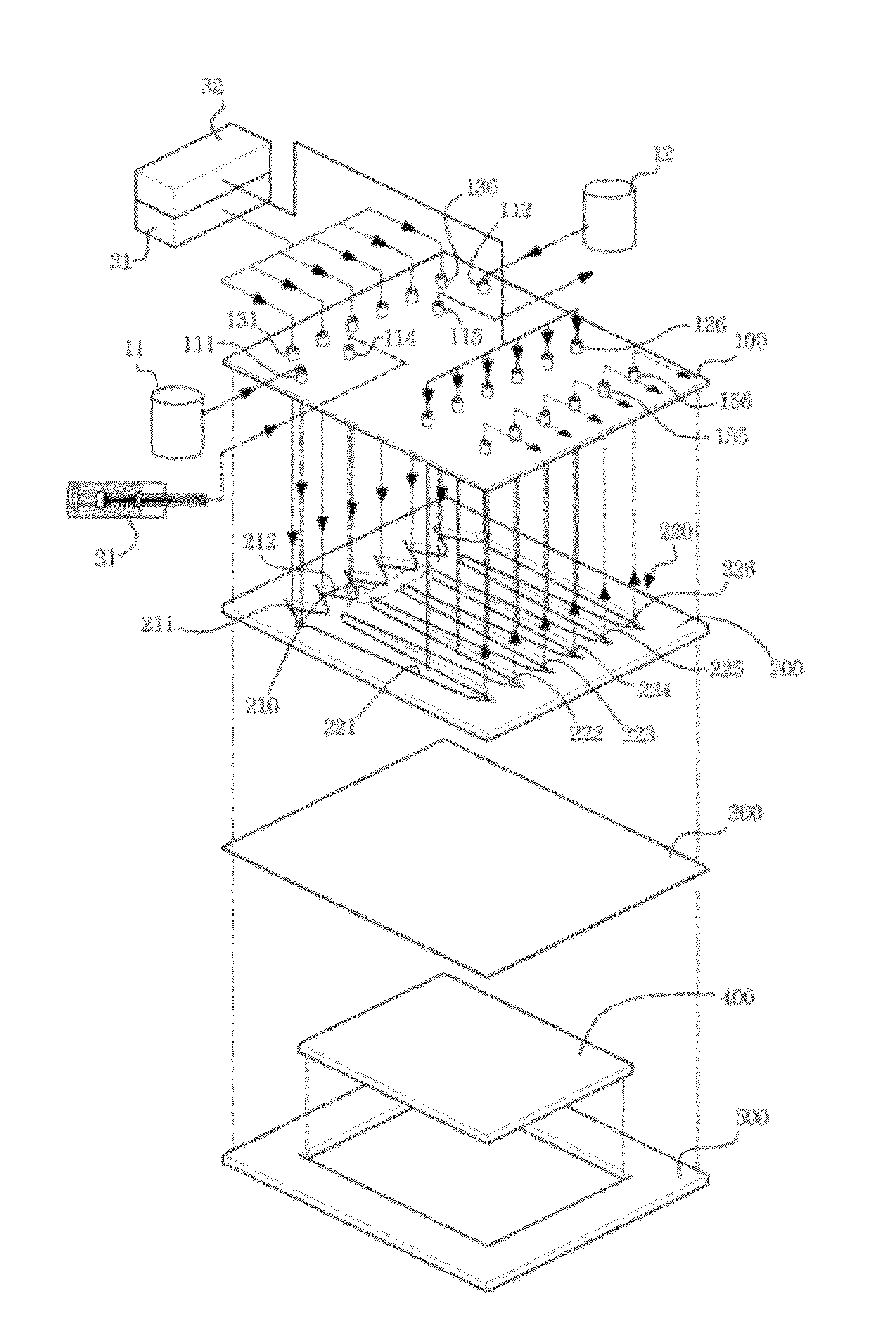Non-gel based two-dimensional protein separation multi-channel devices
a two-dimensional protein and multi-channel technology, applied in the direction of peptides, fluid pressure measurement, liquid/fluent solid measurement, etc., can solve the problems of difficult automation, labor-intensive 2d-page method, complex proteins, etc., and achieve the effect of preventing denaturation of proteins
- Summary
- Abstract
- Description
- Claims
- Application Information
AI Technical Summary
Benefits of technology
Problems solved by technology
Method used
Image
Examples
example 1
Manufacturing of Protein Separating Apparatus
[0110]In order to connect the multiple channels with the tubes, a total of 22 connectors, i.e. six inlets and six outlets, six connectors for discharging the fluid from the six focusing flow parts, two connectors for inflow and outflow of the samples and two connectors for connection with the electrodes within the isoelectric focusing section, employed nuts of the same PEEK (available from Upchurch Scientific, USA), as shown in FIG. 4. The six Teflon tubes of the channel inlets were connected with the first feed pump using a 6-way manifold (having one inlet and six outlets) (available from Upchurch Scientific, USA). The first feed pump employed an HPLC pump. Similarly, the focusing flow inlets for the focusing flow (the six inlets between the channel inlets and the channel outlets) were connected with the second feed pump using Teflon tubes and a 6-way manifold in the same fashion as the channel inlets. The six connectors of the channel o...
example 2
Separation of Single Protein Standard Substance Using Isoelectric Focusing Apparatus
[0114]In order to check an isoelectric focusing effect in the protein separating apparatus (isoelectric focusing-flow field-flow fractionation multi-channel apparatus) manufactured according to the Example 1, a sample, cytochrome-c (12.7 kDa, pI 10.25), was separated by itself, and was mixed with an excessive amount (30 μg) of ampholyte solution in order to visually check a red color of the sample itself. The mixture was injected to the multiple channels using the syringe pump, and then was subjected to isoelectric focusing under the conditions of 3 min, 2 kV, and 1.25 mA.
[0115]As shown in FIG. 6, it can be seen that protein bands are indicated by narrow lines. In FIG. 6, the left side is an anode side, and the right side is a cathode side.
[0116]Further, the isoelectrically focused protein samples become electrically neutral between the opposite electrodes, are no longer electrophoresed toward the el...
example 3
Isoelectric Focusing Difference of Single Protein Caused by Voltage Change in the Event of Isoelectric Focusing
[0117]The efficiency of the isoelectric focusing separation depending on a difference in applied voltage in the isoelectric focusing process using the protein separating apparatus of the Example 1 was examined. A sample, carbonic anhydrase (29 kDa, pI 5.8), was injected at an amount of 1 μg, and was subjected to the isoelectric focusing under the condition that the applied voltage was 1.0 kV, 2.0 kV, 2.5 kV, and 3.0 kV. The results of comparing the conditions of 1.0 kV and 3.0 kV are shown in FIG. 7.
[0118]As shown in FIG. 7, when the applied voltage was 3.0 kV, a sample of carbonic anhydrase was focused within a given time, and was separated only in channel #3. In contrast, when the applied voltage was 1.0 kV, the protein was separated in channels #2, #3 and #4. This means that, when the protein is subjected to the isoelectric focusing, the protein is widely spread without ...
PUM
| Property | Measurement | Unit |
|---|---|---|
| distance | aaaaa | aaaaa |
| depth | aaaaa | aaaaa |
| molecular weight | aaaaa | aaaaa |
Abstract
Description
Claims
Application Information
 Login to View More
Login to View More - R&D
- Intellectual Property
- Life Sciences
- Materials
- Tech Scout
- Unparalleled Data Quality
- Higher Quality Content
- 60% Fewer Hallucinations
Browse by: Latest US Patents, China's latest patents, Technical Efficacy Thesaurus, Application Domain, Technology Topic, Popular Technical Reports.
© 2025 PatSnap. All rights reserved.Legal|Privacy policy|Modern Slavery Act Transparency Statement|Sitemap|About US| Contact US: help@patsnap.com



